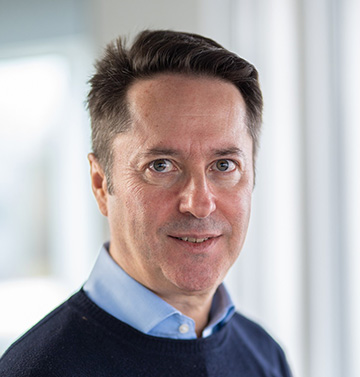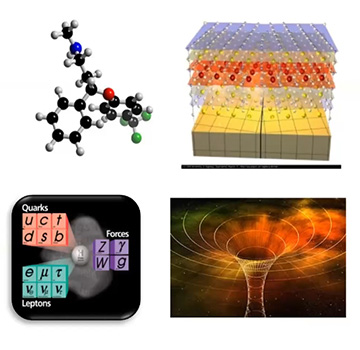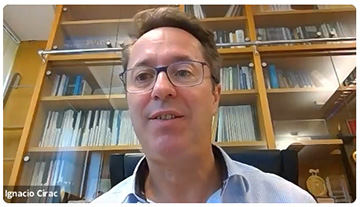
Ignacio Cirac. [Image: MCQST]
Stories about quantum computing often dwell on the exotic hardware platforms now under active development: systems of laser-trapped ions or atoms; cryogenically cooled superconducting circuits; diamonds hosting nitrogen–vacancy centers. But those quantum computers will only be as good as the algorithms written for them—and just which problems will gain the biggest advantage from quantum platforms is a topic of active research.
One area that has seen some early wins is the use of these hardware platforms not as universal computers, but as quantum simulators for solving problems related to the complex dynamics of physical quantum systems. In a keynote address on day 3 of OSA’s new Quantum 2.0 Conference, Ignacio Cirac, a scientist at the Max-Planck-Institut für Quantenoptik in Munich, Germany, shared his work developing algorithms that use quantum simulators to speed up the solution of a particularly tough set of physical problems.
Many-body problems
While Cirac began by noting that he would be talking about “the software part” of quantum computing, he stressed that his work was very much rooted in physics and uses the language of physics, not computer science—“because I myself am not a computer scientist,” he said. The specific family of problems he looks at are so-called quantum many-body problems, an area with profound relevance in physics, chemistry and general science. “Even people talking about black holes,” he said, “are often looking at many-body problems.”

Cirac stressed that quantum many-body problems have relevance across basic physics and chemistry, and even crop up in the physics of black holes. [Image: Ignacio Cirac/OSA Quantum 2.0 Conference]
Those problems, it turns out, are fiendishly difficult to describe and solve on classical computers, requiring prodigious amounts of computational time and memory to provide meaningful insight about systems of any reasonable size. Indeed, Cirac noted, the solution of many-body problems was the original motivation behind Richard Feynman’s proposal of the idea of quantum computers decades ago.
The devil in the details
It is, perhaps, not surprising that quantum computers might be a better fit than classical machines for studying quantum many-body systems. But as always, the devil is in the details. For example, even for a quantum computer, Cirac observed, it turns out that the time it takes for calculating the dynamics for zero-temperature, ground-state multi-body systems scales exponentially with an increasing number of particles or subsystems. There’s a lot of interest at present, he said, in developing so-called heuristic quantum algorithms for such ground-state problems.
Cirac’s own recent work has focused instead on the dynamics of quantum many-body systems at finite energy and temperature—problems that, he points out, are still relevant to many areas of physics. And his work on error-tolerant quantum algorithms suggests that current-era noisy intermediate-scale quantum (NISQ) computers and analog quantum simulators can be powerful tools in cracking such problems. “People are investigating problems for which these computers might be useful,” he said, “even though they’re not perfect and not universal.”
Classical difficulties
Cirac walked the audience through the difficulties these problems pose for classical computers, and several ways that quantum simulators can offer a way out.
The most common classical algorithms for calculating the finite-energy dynamics of many-body systems—exact diagonalization and tensor networks—both scale exponentially in time with the number of particles, Cirac explained. Thus these classical techniques quickly blow up when the system becomes complex enough to be interesting.
A different classical approach for many-body quantum systems, the well-known technique called Monte Carlo simulation, does work more efficiently for calculating the thermodynamics of finite-temperature many-body systems—but only for a certain, narrow range of situations. Outside of that range, the technique runs into a “sign” problem, related to probability calculations, that causes this classical approach, too, to scale exponentially in time as system complexity increases.
Repeated runs
Cirac showed how algorithms built for quantum simulators, such as collections of trapped-ion qubits, can improve on both methods. Such simulators can run the system evolution repeatedly, taking measurements over multiple time steps, and then use those observables to as inputs to a classical calculation of the system’s the energy state.
The power of the quantum simulator approach, Cirac suggested, is that even though it requires multiple runs and measurements, the scaling is still polynomial rather than exponential in time. He even suggested that his algorithm, run on an analog quantum simulator, could be used as a sort of “quantum subroutine” for a classical Monte Carlo algorithm, to avoid the sign problem that would otherwise hang up that technique. And the algorithms that he has developed appear to be sufficiently error-tolerant to apply to present-day NISQ computers and analog quantum simulators.
Algorithms for the here and now

Ignacio Cirac at the OSA Quantum 2.0 Conference.
In a “meet the speaker” session on Wednesday afternoon, Cirac expanded on this last point. While admitting that his talk’s topic was “kind of abstract,” he said that the motivation behind it was to show that there are indeed quantum algorithms that can be applied via current-generation systems such as trapped-ion quantum simulators.
Universal quantum computers with quantum logic gates “can, we know, do many things,” he said. But universal platforms with sufficiently low errors to be useful are still a long way off. Analog quantum simulators, in which a quantum system evolves and provides observable information as the output, are on the scene now—and potentially useful in a range of physical problems.
“People are typically concerned about building algorithms for quantum computers,” Cirac said, “but leave aside these quantum simulators—which are now [already] in many labs.”
